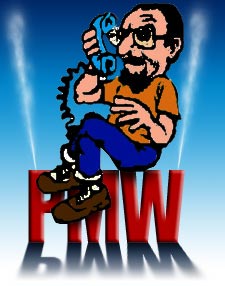|

4/7/03
|

Ed. Note:
Wady Hamam or Pro Mod Wad as he is
known in the sport as drag racing's main
nitrous Guru. He has been involved
in nitrous oxide injection almost
from its inception especially with
the Pro Mod division.. He is originally
from the Buffalo, New York area and
has been involved
in all types of racing from flat track
motorcycles to fuel dragsters. In
his wasted youth he even raced a fuel
funny car powered by a blown and injected
small block Ford! He and his brother
campaigned a front motored Top Fuel
dragster and lost a race against Don
Garlits at the now closed Niagara
Falls Dragway. His advice about nitrous
problems is highly sought after but
he is hard to get to. He has agreed
to answer one question every couple
of weeks for Drag Racing Online readers.
Email your questions to: promodwad@racingnetsource.com,
and he will answer the question he
finds most intriguing.
(Original caricature Pete Millar) |
|
QUESTION 1
Hi. Has anyone come up with a jetting chart
for propane? Or at least an approximate? I would
like to use propane in a dry manifold application,
and I have concerns with fuel puddling if I
were to use gas. Getting to a fuel source is
almost impossible, so using propane as the fuel
would work out great, but I am clueless when
it comes to the jetting.
Thanks you for your help.
X-NOS engineer...
Matthew T. Rondeau
Matt,
Your question is a little confusing as far
as dry manifold application, but let me tell
you what I know about propane.
First: Propane has many, many BTU's and
does make lots of power in an internal combustion
engine.
Second: Propane is stored in its container
at high pressure (around 400psi) and when introduced
into an engine as the fuel source it must pass
through a regulator to drop it down to a usable
pressure.
The people I know of that have used it with
nitrous as the fuel have had to use a high-pressure
solenoid (a nitrous solenoid will work) and
send it into the engine via a plate system or
multiple nozzles in order to work out the jetting
map. The reason for that is that because of
the high pressure, the fuel or propane jet size
is much smaller than the nitrous -- much like
the higher pressure EFI systems.
As an example, if you were to jet a plate
system for 175 HP with a .073 nitrous jet and
.082 fuel jet for gasoline, in a propane system
that fuel jet would be down around a .050 jet
due to the pressure that the propane will be
flowing at.
No one that I know of has ever put the actual
jetting map in print and that is why it is good
to work with a good technical staff at the company
whose system you are using. They have probably
worked with someone that has used propane.
If you are planning on using propane as
the main fuel in the engine and want to use
nitrous as the power adder, then the nitrous
jet will end up being slightly larger for a
horsepower level than normally selected in a
gasoline engine.
Is this all as clear as MUD? Hope I have
shed a bit of light on your question with this
answer and thanks for writing.
Wady
QUESTION 2
I have a 427 small block Chevy with 14.5 compression. I was blowing the head gasket between #6 and #8 cylinders, all 3 times same place. I'm not O-ringed and was not told I had to be. I sprayed 250 horsepower with NOS two-stage plate. I was told either the plate was bad or the retard box was not set right. I bought a new system by a different company that is custom made and flowed on my intake. It's a plate system.
In your professional opinion, what do you think it could have been?
Hope you can help. Thanks.
Mark
Mark,
Not knowing all the parameters
of your 427 or if it was even built for nitrous
use, let me try to give you a sensible answer.
First off any engine that will be sprayed with
250 or more nitrous HP should be O-ringed for
safety, due to the amount of cylinder pressure
that will be created by the nitrous.
What you write is that you were
or still are using a 2-stage plate system and,
yes, that can cause a problem if the plate is
not spot on or the timing does not retard when
the second stage is activated. Sometimes in
a multiple stage system if a jet size is not
exact bad things will happen when the sizes
are stacked or ganged up because the system
flows more than expected and damage occurs.
Because some companies do mass
produce their jets, the tolerance from jet to
jet will vary and can create what you experienced
between cylinders 6 and 8. Hopefully, you did
not get some aluminum ashtrays also and it was
just a gasket.
You did the smart thing by flowing
the new system to your manifold; many times
this will stop problems before they start. If
you or the company flow the jet sizes to double
check, you then can be comfortable that you
are getting what you expected and not damage.
Wady
<
MORE STORIES >
|